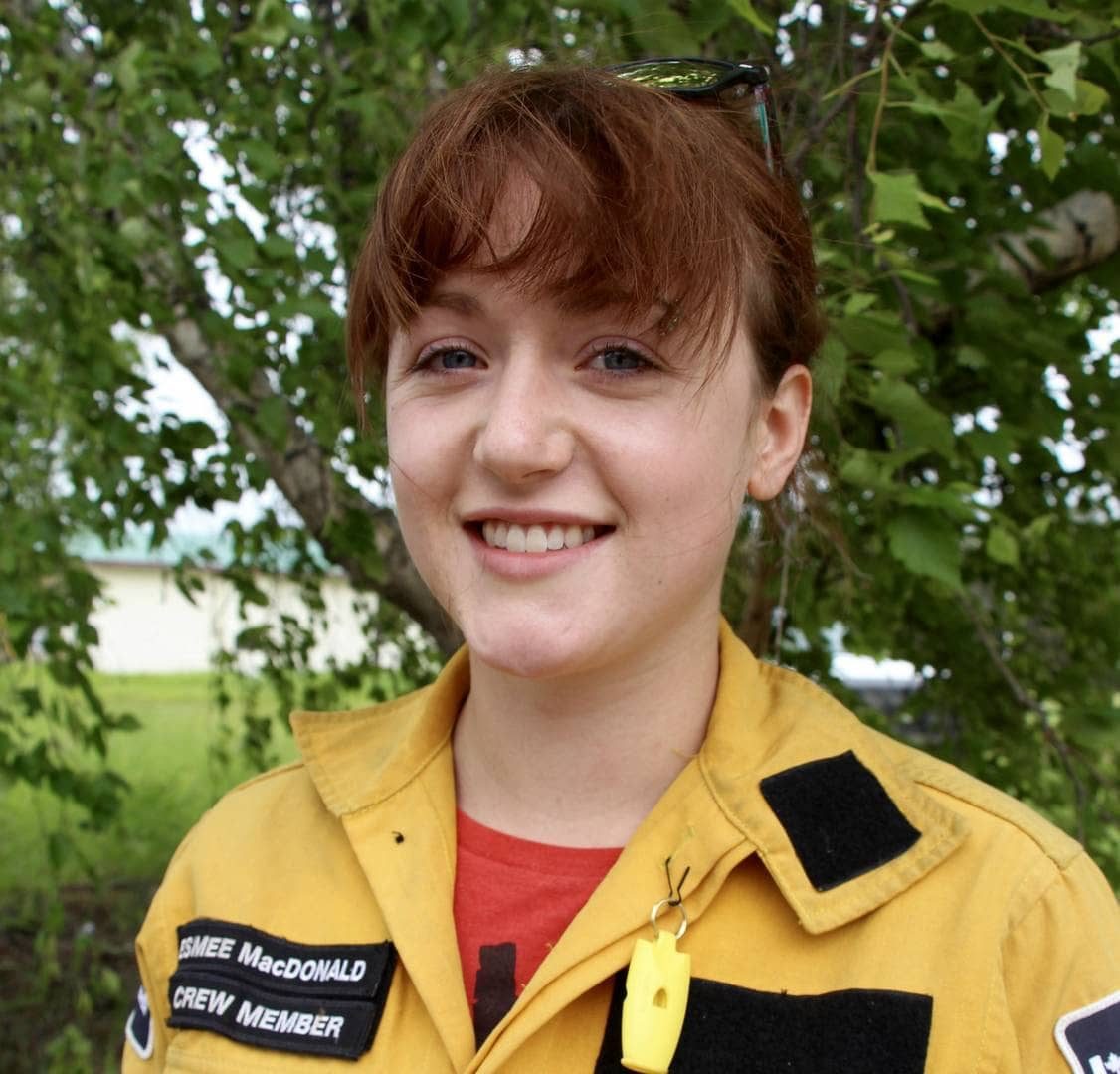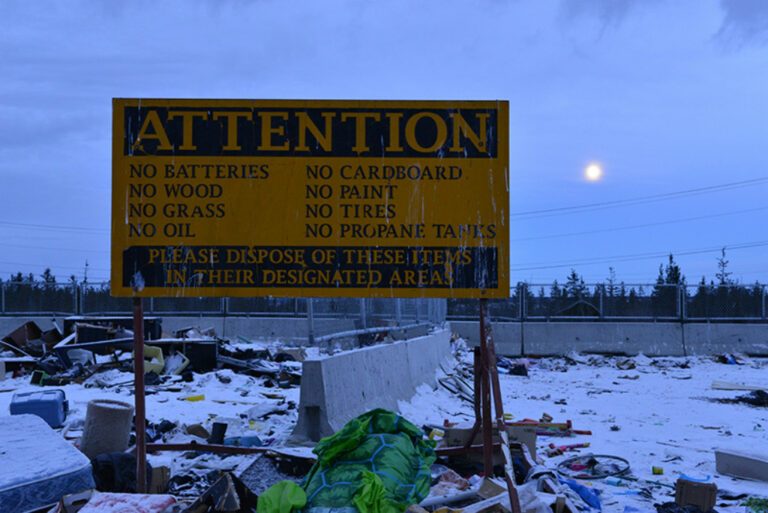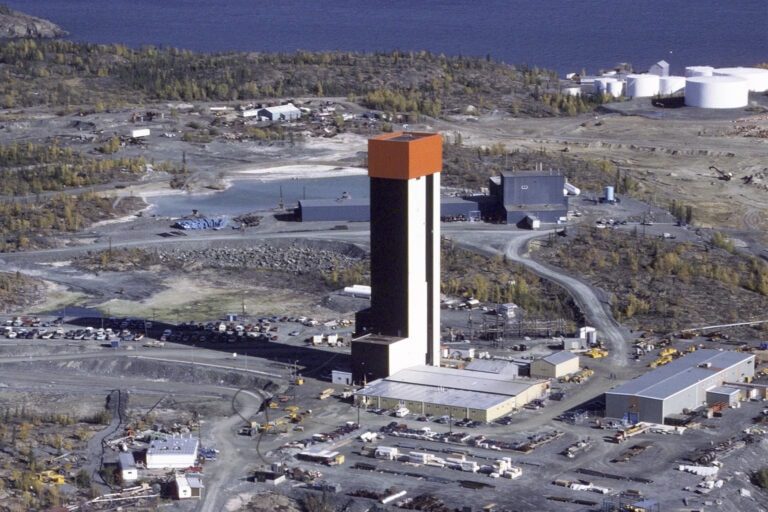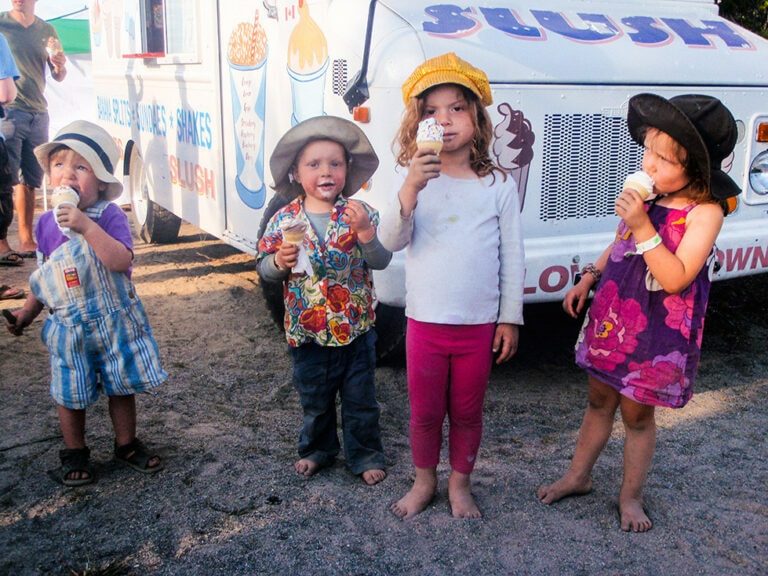This year, the largest national park in Canada has the most women crew members on the fire line in its history, with five female Type 1 wildland firefighters making up a third of its initial attack force.
Initial attack crews are the first to the scene when it comes to boots-on-the-ground fire management. It’s a physically demanding job of laying hose, running pumps, cutting trees, doing smoke patrol and assisting helicopters with bucketing water.
To be Type 1, firefighters have to pass the gruelling annual WFX-Fit fitness test, doing laps while carrying 28 kilogram packs up and down ramps, and pulling a sledge weighing 18.5 kg.
It’s a line of work typically dominated by men, but with more women entering the field each year, the gender ratio is steadily changing.
EDGE spoke with the women of Wood Buffalo’s fire program to talk about their jobs on the fire line.
Melanie Jewell, 29, from Fort Smith, NWT
Fire seasons worked: 3
Why she got into firefighting
“I went backwards in my career,” Melanie says. “I worked for fire management as a public communicator for eight months and then realized that I didn’t want to be behind a desk and I wanted to be out in the field. I just felt too restless behind a desk, reading about what (the fire crews) did — not the glory, but just being active. I appreciated what I learned there, and it made me segue into this job.”
Why she likes her job
“I like working on the fire line and seeing our progress throughout the day, from initially when you get there, to getting to know the fire and then wrapping it. You have that proud moment afterward, looking back on your work to see physically what you did.”
The frequent helicopter trips are also a major highlight.
“That’s just our normal day and it’s super cool.”
What she’s learned so far
Melanie was one of six Wood Buffalo crew members who were sent “on export” to help mop up the recent Fort McMurray blaze. It’s those kind of opportunities, she says, that make her job special.
“Getting to know other crew members from other parks was really exciting, and seeing how they have different methods of doing things I found really interesting,” she says.
What the fitness test was like
“I started training in November with boot camp class. I tried to really focus this year on playing squash and doing cardio, running, and I felt that helped immensely,” she says.
“My first year, I was spent. My second year, I was really tired and barely passed.”
But this year she knocked a minute off her time.
“That felt really good. This year I definitely felt way more confident about it.”
Her advice to other women
Melanie says some of her strongest relationships at work have been with other women.
“I met a really good friend who came here last year from Waterton, and she and I became really good pen pals,” she says. “It’s just about sharing the same interests — being outside and hands-on work — and trying to escape the desk job for as long as possible.”

Esmée McDonald, 20, from B.C.’s Sunshine Coast/Fort Smith, NWT
Fire seasons worked: 2
Why she got into firefighting
Esmée first got the idea to go into firefighting while she was still in high school, at the encouragement of one her male friends.
“He was with the program for a long time and made it seem appealing and accessible, and he was also very much like, ‘Girls can do it, get on board,” she says. “I was always aware of the program, so when I turned 18, it just seemed logical to do it after I graduated.”
“Don’t go into it being like, ‘I wonder what I can do as a woman firefighter;’ more so, I wonder what I can do being me and having certain personality traits that are common across genders.”
Why she likes her job
“I think I love the hands-on aspect,” she says. “It’s missing from so much of daily life unless you’re a tradesperson. You don’t just get to go out and work with your hands and troubleshoot things on a daily basis, or do construction. You get to do that stuff all the time, and it’s so great. It’s using a different kind of skillset that’s very invigorating.”
What she’s learned so far
This spring, Esmée took the intermediate course that qualifies firefighters to become crew leaders.
“It just totally opened my mind to the intricacies of fire behaviour and fire weather,” she says. “I love looking at the clouds now. In the classroom we were cursing inversions and cold fronts and upper ridge breakdowns, but then you can see it in action. It’s such a tangible thing and it’s so fascinating to be able to walk out of the classroom and immediately apply your skills for a job like this.”
What the fitness test was like
“There was just an immense sense of relief when I had actually started the test, because for me it’s always so much more psychological than anything. I totally thought I was going to fail, and then I was a minute-and-a-half faster than I thought I would be. But once I started, I just thought this is what I’ve been training for, this is the moment, and now I can just do it and be done with it.”
She says it’s a testament to everyone’s strength that all the members passed their test, despite the palpable amount of anxiety in the room before the show.
“And I know it shouldn’t be the case, but that moment when you realize you beat some of the guys is interesting,” she adds with a laugh.
Her advice to other women
“My advice would be to not fall in the trap of stereotyping yourself,” she says. “Don’t go into it being like, ‘I wonder what I can do as a woman firefighter;’ more so, I wonder what I can do being me and having certain personality traits that are common across genders.”
“They tell us all the time: You can be the strongest, but if you don’t have grit or tenacity or good morale or a good sense of humour, you’re just not going to make it. It doesn’t boil down to being a boy or a girl, it boils down to a set of characteristics that apply to this job.”

Robin Lafreniere, 28, from Winnipeg/Dog Creek First Nation, Manitoba
Fire seasons worked: 2
Why she got into firefighting
Robin hadn’t heard of the program until she met one of her fellow crew members going to university in Edmonton, who encouraged her to apply.
She says it was appealing because it fit her lifestyle.
“I’ve just always known that I love the bush and anything to keep me out there is something that I strive for in my life.”
Why she likes her job
“My favourite part is IA-ing [initial attacking] a fire,” she says. “It’s very exciting. Just getting up right in there with a fire and working with a crew, it’s bonding, it’s exciting, it’s fun. Even through really hard times, you laugh about things after. It’s just a great atmosphere. And I love learning, especially from the oldtimers.”
What she’s learned so far
Robin started her fire career last summer during an intensely active season. With abundant rains this year, her second season is a little slower, though just as enriching.
“The first year was very, very exciting and I was learning a lot out there in the field. I barely had time to rest. This season is completely the opposite, so there’s more time spent learning academically about fire behaviour,” she says. “I’m pretty content with both aspects, because I’m still learning a lot.”
What the fitness test was like
“What I always found going through the fitness test is you go through three walls,” Robin says. “They’re just barriers, these blocks where you’re like, ‘Oh my god, I can’t breathe. I can’t think.’ And it hurts. But once you get past those — the first wall especially — you feel like a super woman after. It’s a great feeling.”
Her advice to other women
“It’s all about personality, what you put out there. It’s working as a crew. You get very familiar to all the characters around you and quite close — they become brothers to you. It’s just a family dynamic. It makes a huge difference compared to a lot of other workplaces, where people are doing individual work. With this, you have to work together.”

Robyn Brown, 24, from Vancouver, B.C./Fort Smith, NWT
Fire seasons worked: 1
Why she got into firefighting
Robyn had a couple of classmates in the Environment and Natural Resources Technology Program at Aurora College who encouraged her to apply.
“I remember them saying they had no doubt that I could do it, so that really planted the seed in my head, and the more I thought about it, the more I realized it would be really perfect for me,” she says. “I really love being outside and I always wanted to see the park, and it was a great opportunity to do that.”
Why she likes her job
It’s her first season, so Robyn hasn’t had to initial attack a fire yet, but says working with helicopters has been exciting, especially in Fort McMurray, where she also went on export.
“It was just a huge airshow, just so many helicopters,” she says. “Being able to see the landscape in that way was something I’ve always wanted to do, so that’s been my favourite part.”
What she’s learned so far
“For me, the most interesting thing has been learning to work with the pumps. I’ve never done that before, and it’s not just learning how to work the equipment — which is satisfying once you can start the Mark 3 all by yourself! It’s really great,” she says.
“But on the other side, there’s the strategy of how to use it. When I was in Fort McMurray, there was this one site where we had all the pumps set up, and it was just a really big project and cool to see the strategy and be a part of that. Then there’s the satisfaction at the end of the day when there’s no smoke in the air and you realize we did that.”
What the fitness test was like
“I’d had a month to prepare, doing fitness training every morning and getting advice from all of my co-workers,” she says.
“At the beginning, you’re sort of focused on that 50-pound bag that you have to carry and the big mock pump and you think it’s a strength thing, but at the end you realize it’s cardio,” she says.
Though Robyn thought she only had a couple of seconds left at the end, it turns out she had a minute and a half remaining.
“I did a lot better than I thought I would do, actually. It really makes you feel like you can do anything after that.”
Her advice to other women
Robyn wants other young women to know that Wood Buffalo’s fire program is a supportive place to work.
“I think it’s very fun and empowering to be able to work with a lot of the equipment and the great people we work with. It’s a great dynamic.”

Katie Ellsworth, 37, from Ontario
Fire seasons worked: 13
Why she got into firefighting
Though Katie has never worked as a wildland firefighter, she has been involved in fire management at national parks across Canada since 2004, when she was a park warden in Prince Edward Island.
“Fire management was part of my old duties as a park warden, and it always interested me,” she says. “I like the pace of the work, the variety of the work.”
She moved into fire and visitor safety in 2007 at Thousand Islands National Park in Ontario, leading two Type 2 fire crews there. “We really started revamping and getting their prescribed fire program running again.”
After working in six parks, she and her family moved to Fort Smith last year, where she works as Assistant Fire Management Officer for Wood Buffalo. This is her second season in that role.
“It was a lifestyle choice for my family to see more of Parks Canada,” she says. “We’re a Parks family, so we want to experience all of the parks system.”
Why she likes her job
“I really enjoy the diversity of the work, because I’m not a firefighter, so I get to do a lot of other stuff. I get to work on the plan and on the communications side, and the science stuff — the monitoring and the setting of prescriptions and weather,” she says. “Then I have the opportunity to get out on the line sometimes, as well. So I really enjoy the all-encompassing diversity in my day-to-day job.”
In particular, she finds the training aspect — working with the crew members — especially rewarding.
“There’s 15 of them that need to be encouraged and found work for everyday,” she says. “I really like getting everyone to those levels and teaching people things that I’ve learned from some very big fire minds. Throughout my career I’ve worked with some amazing fire mentors and professionals, so sharing that knowledge with these guys as time goes on is very rewarding for me.”
What she’s learned so far
Katie says her comfort level has increased this year from last.
“Last year, the season really came fast and hard. It was really about just survival some days, just try not mess up and do the best you can. This year, the pace is a little different, so it feels a little more comfortable,” she says.
Prior to moving to Wood Buffalo, she was used to a small fire program where she was essentially the only dedicated resource. Now an assistant manager in one of the country’s biggest fire regimes, there is more to think about.
“Here, it’s such a big program and there’s not only crew members, but there’s store people, radio operators, a tower men, umpteen weather stations, two techs — it’s a very big program,” she says. “But this year, I feel a lot more comfortable in my seat.”
What the fitness test was like
Because she’s not a firefighter, Katie doesn’t have to do the hardcore fitness test. Instead, she marches along her crew on the sidelines, cheering them on and getting them across the finish line.
“All the women performed so well on their WFX-Fit this year and last year. They all slayed it,” she says. “To see people struggle physically and to be able to support them through a really tough physical challenge is really fulfilling, because it’s that personal Everest. To see everyone so empowered at the end of the day is really awesome for me.”
Her advice to other women
“It’s accessible to everybody. It’s not about being a woman or man. It’s not about your size or your gender. It’s about who you are at the core. It’s a bunch of people who really interested in a challenging, adventurous, outdoors-oriented career and we all know those pleasures are not limited to men or women.
“These women are as trained as any other Type 1 firefighter in the country. It doesn’t matter if their name is Melissa or Morris, you get the same skill set, same aptitude, same ability, same training.
“But I’d really like to say that these women are blazing trails for the women coming behind them. They may not know that they are, but they are.”
EDGE is now covering the South Slave! For your daily dose of the NWT’s best news, features and analysis, become a member for as little as $4.95/month. Click here to join the team.








